SkyTrain rolling stock
The SkyTrain is a rapid transit system located in Metro Vancouver, with a number of different models of rolling stock.
| SkyTrain rolling stock | |
|---|---|
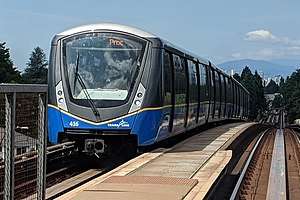 Innovia Metro Mark III train near Nanaimo station | |
| In service | Expo & Millennium Lines: Mark I: (150) 1985–present Mark II: (108) 2002–present Mark III: (28) 2016–present Canada Line: EMU: (40) 2009–present |
| Manufacturer | Bombardier (Mark II/III) Hyundai Rotem (EMU) Urban Transportation Development Corporation (Mark I) |
| Number built | 326 cars |
| Number in service | 326 cars |
| Formation | 2 cars per trainset (EMU/Mark II) 4 cars per trainset (Mark II/III) 6 cars per trainset (Mark I) |
| Operator(s) | British Columbia Rapid Transit Company (Expo & Millennium Lines) ProTrans BC (Canada Line) |
| Depot(s) | Expo & Millennium Lines: SkyTrain Operation and Maintenance Centre (1985–present) Coquitlam Maintenance Centre (2016–present) Canada Line: Canada Line Operation and Maintenance Centre (2009–present) |
| Specifications | |
| Maximum speed | 80 km/h (50 mph)[1] |
| Electric system(s) |
|
| Track gauge | 1,435 mm (4 ft 8 1⁄2 in) standard gauge |
Summary
| Builder | Model | Year acquired | Fleet size |
|---|---|---|---|
| Urban Transportation Development Corporation | ICTS Mark I | 1984–1986 | 114 cars: 001 to 056; 061 to 118 |
| Urban Transportation Development Corporation | ICTS Mark I | 1990–1991 | 16 cars: 121 to 136 |
| Urban Transportation Development Corporation | ICTS Mark I | 1994–1995 | 20 cars: 137 to 156 |
| Bombardier Transportation | ART Mark II | 2000–2002 | 60 cars: 201 to 260 |
| Bombardier Transportation | ART Mark II | 2009 | 34 cars: 301 to 334 |
| Bombardier Transportation | ART Mark II | 2010 | 14 cars: 335 to 348 |
| Bombardier Transportation | Innovia Metro Mark III | 2016 | 28 cars: 401 to 428 |
| Bombardier Transportation | Innovia Metro Mark III | 2018–2020 | 56 cars: 429 to 484 |
| Hyundai Rotem | EMU | 2009 | 40 cars: 101 to 120; 201 to 220 |
| Hyundai Rotem | EMU | 2019–2020 | 24 cars: 121 to 132; 221 to 232 |
| Model | Seats/car | Capacity/car | Cars/train | Length/train | Capacity/train |
|---|---|---|---|---|---|
| ICTS Mark I (1984–1995) | 22–36 | ~80 | 4 or 6 cars | 50.8 or 76.2 m (166 ft 8 in or 250 ft 0 in) | 320, or 480 |
| ART Mark II (2000–2002) | 42 | 123 | 2 or 4 cars | 34.7 or 69.4 m (113 ft 10 1⁄8 in or 227 ft 8 1⁄4 in) | 256 or 512 |
| ART Mark II (2nd generation; 2009/2010) | 33 | 130 | 2 or 4 cars | 34.7 or 69.4 m (113 ft 10 1⁄8 in or 227 ft 8 1⁄4 in) | 264 or 528 |
| Innovia Metro Mark III (2016–present) | 30–33 | 131–135 | 4 cars | 68.1 m (223 ft 5 1⁄8 in) | 532 |
| Hyundai Rotem EMU (2009–present) | 44 | 167 | 2 cars | 41 m (134 ft 6 1⁄8 in) | 334 |
Expo Line and Millennium Line
The Expo Line and Millennium Line Bombardier Advanced Rapid Transit (ART) technology is a system of automated trains driven by linear induction motors, formerly known as the Intermediate Capacity Transit System (ICTS). These trains reach speeds of 80 kilometres per hour (50 mph);[1] including wait times at stops, the end-to-end average speed is 45 kilometres per hour (28 mph), three times faster than a bus and almost twice as fast as a B-Line express bus.[3]
UTDC ICTS Mark I fleet
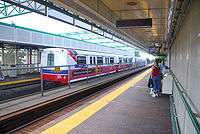

The original fleet consists of 12 metres (39 ft 4 1⁄2 in) lightweight Mark I ICTS cars from Urban Transportation Development Corporation, similar to those still used today by Line 3 Scarborough in Toronto and the Detroit People Mover.[4] Mark I vehicles are composed of mated pairs and normally run as six-car trains, but can also be run in two- and four-car configurations. The maximum based on station platform lengths is a six-car configuration, totaling 72 metres (236 ft 2 5⁄8 in) The SkyTrain fleet currently includes 150 Mark I trains.[5] These trains have side-facing seats; red, white, and blue interiors; and two doors per car. However, some repainted units feature only blue and white interiors.
Each Mark I car has 36 seats and a capacity of 80 passengers.[6] Mark I trains have spaces dedicated for wheelchair users, bicycles, and strollers.

The Mark I ICTS cars built between 1984 and 1986 for the first/1985 phase of the Expo Line featured two end-doors, one at the front and back of each car. The back side of each car had sections painted in black. These trains were different from the test train couple used during the ICTS testing in 1983. There are a total of 150 Mark I cars: 114 dating from 1984–1986, which have run an average of more than 3.2 million km apiece; 16 added in 1991 for the Scott Road extension; and 20 added in 1994 for the King George extension.
In 1991, additional Mark I ICTS cars were purchased. These newer cars featured no end doors, and the back side was not coloured black. The ends of each car had no doors; instead, the windows were slightly enlarged and the front was equipped with an electric motor driven windshield wiper. Trains include a fold-down seat near the front ends that permit a rider a view of the tracks from the end car.
When the 1984/86 fleet of ICTS cars were introduced, floors were carpet-lined, intended as a way to showcase SkyTrain as an elegant world class system. However, as maintaining the carpets proved difficult and sanitation issues quickly became a concern, they were replaced with wax flooring in the mid-1992. The Expo fleet of trains also initially equipped with passenger-initiated door buttons, meaning that individual door sets only opened at the push of a button when passengers wished to get on or off at a particular station. The buttons were removed between 1989 and 1991, due in large part to passenger confusion as to how to properly use the buttons as well as doors jamming, thus leading to the issue of frequent system-wide or area-specific delays.
Between the late 1990s and early 2000s, just prior to the opening of the Millennium Line, SkyTrain gradually refurbished the entire Mark I train fleet in terms of design and layout. This included minor and major paint scheme changes before and following the shift from BC Transit to TransLink, upgrading of signage, changes to seating fabric colour scheme and seating arrangement, and a complete re-recording of the station announcement system that had been in use since 1985.
From the beginning of the system's revenue opening in January 1986, SkyTrain operated daytime service with two-car and four-car Mark I trains running at a target five-minute frequency. During Expo 86, four-car trains were primarily used to manage the large-scale population flow of the fair. In the years following, two-car trains were operated on off-peak hours, late evenings and Sundays, while four-car trains were used to handle peak periods and large downtown events such as concerts, marathons, and hockey games. Two-car trains were gradually phased out between 1990 and 1993 in response to complaints about overcrowding. At the opening of the second part of the phase two extension to Scott Road Station in 1990, six-car trains were used for the first time at reduced frequency while an operation glitch in the system's computer network had to be corrected and re-programmed.
Prior to the opening of the Millennium Line, four-car trains became standard because SkyTrain could operate frequent service (about 150 seconds) during peak hours. The opening of GM Place (today called Rogers Arena) also brought an increase in the number of special events (hockey, concerts, and the short-lived trial of basketball) which required extended capacity during the evenings. Two-car trains only operate during train maintenance and testing at the BCRTC Edmonds Maintenance and Storage Facility in Burnaby.
In 2013, the oldest 114 Mark I cars began being refurbished to extend their intended lifespan another fifteen years, from 2011 to 2026.[7] The refurbishment included an interior and exterior repainting (in the current blue–grey TransLink livery), removal of seats to increase capacity, and the replacement of various systems.[8] As of July 2017, these original cars were all repainted, but not all refurbished. The project, which will ultimately see all Mark I cars updated, is expected to be finished in April 2020.[7]
As of October 22, 2016, leading up to the opening of the Evergreen Extension on December 2, Mark I trains no longer mainly operate as four-car trains; they commonly operate in a six-car configuration (though four-car formations do occasionally appear should there be additional cars in maintenance).[9]
Bombardier ART Mark II train fleet
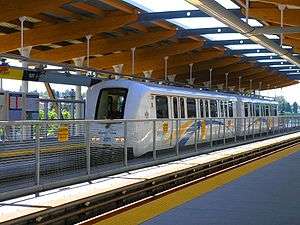
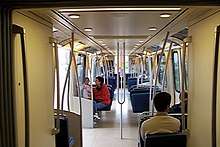
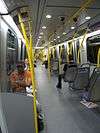
When the Millennium Line was built, TransLink ordered new-generation Mark II ART trains from Bombardier Transportation, 50 of which were manufactured in a Burnaby factory.[10] Similar trains are used in Kuala Lumpur's Kelana Jaya Line, New York's JFK AirTrain, and the new Beijing Airport Express. These trains are usually seen in two-car and four-car configurations. Each pair of cars is permanently joined together in a twin unit or "married pair", with a length of 33.4 metres (110 ft). Mark II trains have a streamlined front and rear, an articulated joint allowing passengers to walk the length of a married pair, white/grey/blue interiors, and three doors per car.
Like Mark I trains, Mark II vehicles are fully accessible, with dedicated spaces for wheelchair users, strollers, and bicycles. The first-generation Mark II vehicles each have 41 seats and a capacity of 130 passengers, although trains have carried up to 150 passengers under crush load.[6]
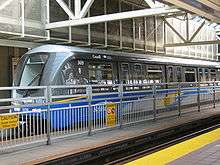
There were 60 Mark II cars added in 2002 for the Millennium Line and ridership growth on the Expo Line.[11] In November 2006, Bombardier won a contract to supply a further 34 second-generation ART Mark II cars with a bid of $113 million. The second-generation Mark II vehicles have fewer seats and wider aisles than their first-generation counterparts, providing more space for standees, wheelchairs, strollers, and bicycles; they have 33 seats and a total capacity of 145 passengers. The second-generation Mark II trains also feature interactive LED maps, destination boards in the front and back windows of the train, more handlebars, door indicator lights, and video cameras.[12] These cars were painted in the newer TransLink livery appearing on buses at the time. The trains were manufactured and assembled in Sahagun, Mexico, and Thunder Bay, Ontario.[13] An additional 14 ART Mark II second-generation cars were ordered for delivery in early 2010.[14] The first of these trains entered regular service on July 3, 2009.
With the acquisition of the initial 60 larger Mark II cars in 2002, SkyTrain chose to operate most in two-car trains (capacity ~260 passengers). This was a reasonable match to the four-car Mark I trains (~320 passengers), allowing six-minute off-peak service on both branches of the line and three-minute service on the inner portion between Waterfront and Columbia stations, while sustaining a practical operation during peak hours (55 trains in service, with a 108-second frequency between Waterfront and Columbia stations).
With the May 2010 fleet expansion of 48 cars to accommodate ridership growth, SkyTrain reconfigured most of the first- and second-generation Mark II cars into four-car trains, which provide more capacity with the same number of trains (55) at the same headway (108 seconds).
Bombardier Innovia Metro 300 (ART Mark III) train fleet
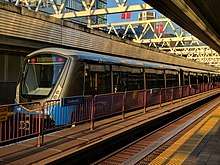
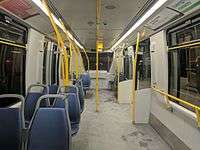
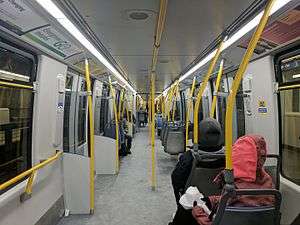
With SkyTrain expanding current operations by adding additional train capacity to existing lines (notably the busiest route, the Expo Line), as well as constructing new lines that use LIM rail for propulsion (such as the Evergreen Extension), TransLink has placed further orders for Bombardier ART train cars. The construction for Evergreen Extension includes the purchase of 28 new cars[15] and an option (which was exercised on December 16, 2016)[16] to order 28 additional cars to increase network capacity. As part of plans to gradually increase Expo Line capacity, eventual operation of all five-car Mark II/III trains is anticipated to maximize usage of the current 80-metre (260 ft) platform length. Constructing longer platforms at all existing Expo Line stations is not currently contemplated.[17]
The Bombardier ART Mk-III model, also known as Innovia Metro 300, is the newest iteration and redesign from the original UTDC ICTS model. Dimensions are similar to the Mark II, with the vehicles appearing sleeker along with larger windows on both sides of the train, and redesigned windows and headlights on the ends of the cars. Capacity is improved through redesigned interior layout, such as the removal of a section of seats. Also similar to the trains used on Canada Line, the Mark III cars have large LED displays on the ends of the exterior and interior of the train, displaying the terminus station on exterior signs, with interior displays showing next station, terminus station, and system announcement information. Bombardier also presents a similarly designed vehicle, called Innovia Metro 300, as its new ART model.[18] In the future, most TransLink orders will likely be for the currently offered Mark III design.
The first Mark III vehicles entered service on August 18, 2016, on the Expo Line.[19] They were temporary pulled from service pending further testing on September 26, 2016, when one of the trainsets lost power while crossing the Skybridge a few days earlier.[20] An additional 28 cars were ordered later that year and arrived between 2018 and 2019;[21] a second fleet expansion of 56 cars was announced in early 2018 and was delivered in 2019 as part of the 10-year vision plan.[22]
Canada Line
Hyundai Rotem EMU fleet

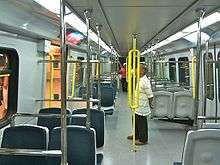
The Canada Line's Hyundai Rotem cars uses different train propulsion technology than Bombardier ART cars, being powered by conventional electric motors rather than Linear Induction Motor (LIM) technology, and therefore incompatible with the other SkyTrain lines. There are a total of 20 trains, which were built by Hyundai Rotem in Changwon, South Korea, operate as two-carriage articulated units, and can reach a speed of 80 kilometres per hour (50 mph) in normal operations, or 90 kilometres per hour (56 mph) in catch-up mode.[23] They are maintained at a yard next to Bridgeport Station in Richmond.
The Hyundai Rotem cars are 3 metres (9 ft 10 1⁄8 in) in width and 20 metres (65 ft 7 3⁄8 in) in length, both wider and longer than the Bombardier Mark I, Mark II and Mark III trains. Each two-car train has seating for 88 and a normal capacity of 334 passengers at four passengers per square metre, with crush load capacity of 400.[24] Therefore a two-car Hyundai Rotem train has more capacity than a four-car Mark I train. The trains feature large, dedicated spaces for wheelchair users, bicycles, and strollers, and sufficient space between seats for luggage. The trains also have large LED displays on both ends of the exterior and interior of the train, displaying the terminus station on exterior signs, with interior displays showing next station, terminus station, and system announcement information.
As with the other SkyTrain lines, ridership on the Canada Line is expected to increase in the future, and eventually capacity will need to be upgraded. The capacity of the line can be increased by 50 per cent through an increase in frequency by adding more trains and another 50 per cent through lengthening trains to a three-car configuration.[25][26] An experiment in August 2016 saw two trains with 20 seats removed in each train in an attempt to increase passenger capacity.[27] Unlike Bombardier ART trains, the Hyundai Rotem trains will not be operated as longer four- or six-car trains. Through inserting a middle "C" car at the articulated joint between two end cars, available capacity will be similar to a four-car Mark II or a six-car Mark I train. The Canada Line's station platforms are expandable to 50 metres (160 ft) in length to accommodate these future three-car trains; the five busiest stations are already 50 metres (160 ft) in length. The Canada Line has a designed future capacity of 15,000 pphpd when operating three-car trains at two-minute headways.[28]
References
- "Quick Facts". Archived from the original on August 6, 2019. Retrieved November 27, 2016.
- https://www.translink.ca/-/media/Documents/plans_and_projects/rapid_transit_projects/Expo%20Line%20Upgrade%20Strategy/Expo%20Line%20Upgrade%20Strategy%20%20Project%20Summary.pdf
- "Burnaby/New Westminster Area Transit Plan Summary Report" (PDF). Archived from the original (PDF) on January 9, 2005. Retrieved December 13, 2006.
- "Vancouver SkyTrain Network, Canada". railway-technology.com. Retrieved December 5, 2008.
- "Specifications: Vancouver SkyTrain Network, Canada". railway-technology.com. Retrieved December 5, 2008.
- "Larger capacity, but fewer seats in new SkyTrain cars". The Province. May 7, 2009. Retrieved July 22, 2009.
- "Behind The Scenes: A look into the remake of a Mark I SkyTrain". The Buzzer blog. July 24, 2017. Archived from the original on August 4, 2017. Retrieved July 26, 2017.
- Meiszner, Peter (November 20, 2013). "Translink begins refurbishing 114 Skytrain cars to extend lifespan". Global News. Retrieved July 4, 2017.
- Coling, Adrienne (September 19, 2016). "Everything Evergreen: New SkyTrain operating pattern for Expo and Millennium Lines". The Buzzer blog. Retrieved July 4, 2017.
- "Questions about Skytrain $". CBC News. May 25, 2000. Retrieved February 3, 2007.
- "Livable Regional Strategic Plan 2002 Report" (PDF). Greater Vancouver Regional District. Archived from the original (PDF) on June 21, 2007. Retrieved June 10, 2007.
- "Improved interiors for the new SkyTrain cars!". Buzzer Blog, TransLink. May 6, 2009.
- "Bombardier lands $113M deal with Vancouver SkyTrain". CBC News. November 23, 2006. Retrieved December 15, 2006.
- "TransLink to spend $150M on buses, SkyTrain by 2010". CBC News. April 11, 2008. Retrieved December 5, 2008.
- Infrastructure, Transportation and. "Contract signed with Bombardier to supply Evergreen Line SkyTrain cars". archive.news.gov.bc.ca. Retrieved March 26, 2016.
- "TransLink to buy 28 new SkyTrain cars for $93 million". Business in Vancouver. Retrieved December 17, 2016.
- "Expo Line Upgrade Strategy" (PDF). TransLink. Retrieved September 18, 2016.
- Bombardier. "Bombardier Innovia ART". Retrieved September 30, 2016.
- "First Vancouver SkyTrain Mark III vehicle enters service". Railway Gazette. August 19, 2016. Retrieved August 22, 2016.
- Jeff Nagel (September 26, 2016). "TransLink 'not disappointed' after new SkyTrain stalls". Maple Ridge & Pitt Meadow Times. Archived from the original on September 27, 2016. Retrieved September 30, 2016.
- Saltman, Jennifer (December 16, 2016). "28 new SkyTrain cars ordered for Expo, Millennium lines". Vancouver Sun. Retrieved September 13, 2019.
- Saltman, Jennifer (December 17, 2018). "New SkyTrain cars arriving behind schedule". Vancouver Sun. Retrieved September 13, 2019.
- "The Canada Line Factsheet – The Canada Line Vehicle" (PDF). Greater Vancouver Regional District. Retrieved December 5, 2008.
- "Canada Line Fact Sheet The Canada Line Vehicle" (PDF). canadaline.ca (TransLink). December 14, 2007. Archived from the original (PDF) on March 26, 2009. Retrieved June 16, 2015.
- Ken Hardie. "Translink's Olympic-sized mistake". Archived from the original on January 22, 2010.
- Chan, Kenneth (August 14, 2014). "Short platforms and trains: Is the SkyTrain Canada Line under-built and near capacity?". Daily Hive. Retrieved December 6, 2017.
- "TransLink modifies two Canada Line trains, removes some seats". News1130. Retrieved December 6, 2017.
- "Canada Line Construction Environmental Management Plan" (PDF). ProTransBC. Retrieved September 9, 2009.